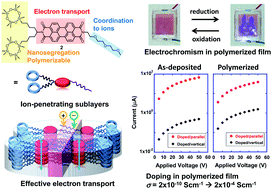Anisotropic electrical conductivity of n-doped thin films of polymerizable liquid-crystalline perylene bisimide bearing a triethylene oxide chain and cyclotetrasiloxane rings†
Abstract
A polymerizable liquid-crystalline perylene tetracarboxylic bisimide (PTCBI) derivative bearing a triethylene oxide chain and cyclotetrasiloxane rings was synthesized. The compound exhibited a lamello-columnar phase in which the electron transport channels and ion-conductive sublayers were nanosegregated. Time-of-flight measurements revealed that the electron mobility of the columnar phase was on the order of 10−3 cm2 V−1 s−1. Thin films of the compound were produced by a spin-coating method, and the resulting films were polymerized and insolubilized via exposure to the vapors of trifluoromethanesulfonic acid. The uniaxially aligned thin films were doped in an aqueous solution of sodium dithionite. The electrical conductivity of the as-deposited and polymerized films increased to 10−4 S cm−1 in the doped states because ionic species can penetrate the ion-conductive sublayers. The anisotropy in the electrical conductivity of the as-deposited and polymerized thin films exceeds 100 and 10, respectively, in the doped states.


 Please wait while we load your content...
Please wait while we load your content...